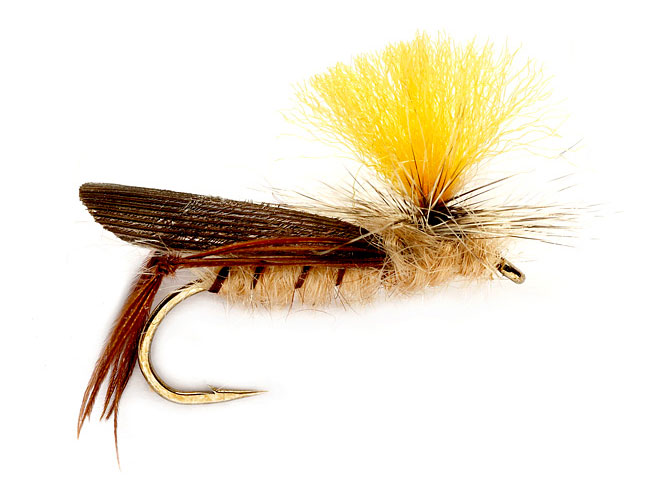If you think terrestrial imitations are only for summer fishing, you’re missing a great deal of dry-fly action. The normal thought is that trout ignore land-bred insects in the spring and early summer, until mayfly and caddisfly hatches dwindle with the heat of summer. They ignore terrestrials about as much as you ignore chocolate mousse when out to dinner.
If you fish small streams, terrestrials are even more important than in larger rivers. A trout’s diet in some small streams is made up almost entirely of terrestrials, as these smaller waters don’t have large expanses of insect-producing riffles. This may be why such so-called “attractor” flies like Humpys and Royal Wulffs are so effective in small streams—both flies, from a trout’s-eye view underneath, look suspiciously like beetles or other land-bred insects. And an Elk-Hair Caddis looks very much like a tiny early-season grasshopper. But, you say, these flies have wings. So do beetles, bugs, katydids, and many ants!
Unlike fish responding to a hatch, trout can be eating terrestrials and you’ll never notice. One reason is that they might see a beetle only once or twice an hour, and the chances of you looking at exactly the right spot aren’t good. An even more important reason is that when trout eat low-floating terrestrial insects, there is hardly ever a splash. Sometimes you see a subtle ring on the water, sometimes a black snout poking above the surface, and sometimes you see a hopper just disappear into a hole in the water with no visible sign of a rise. Best places to try a terrestrial fly are where riffles deepen into a dark slot (especially near a deep bank but not necessarily), in concave impressions along a bank that form small bays, and along undercut banks, especially ones that flow through meadows.
Finally, one of the most deadly midsummer rigs I’ve ever used is a tiny nymph tied as a dropper to the bend of the hook of a beetle or hopper. Tie a size 14 beetle or ant to a 12-foot 5X leader. Knot an eight-inch piece of 6X Mirage tippet to the bend of the hook of the beetle with a clinch knot, then tie a size 18 Pheasant Tail Nymph to the end of the 6X tippet. You’ll catch about half of your fish on the beetle, and on the other 50% you hook on the nymph, the beetle makes a damn good but subtle strike indicator.
Tips for Fishing Terrestrials
- Be as stealthy as with any other kind of dry-fly fishing, but some times a fly that lands with a distinct plop will catch their attention. Point your wrist slightly below the horizontal at the end of the cast. Practice this before you try it on live fish!
- Don’t ignore the center of the river with terrestrials. Most ants and beetles fall into the water along the bank, but the current eventually draws them to the center of the river. A Skilton Quick Sight Ant or Quick Sight Beetle is often deadly fished in fast riffles.
- An occasional twitch can be effective, but don’t overdo it. Try casting downstream with some slack in your leader, then make the fly twitch just a fraction of an inch with your rod tip. Immediately drop the rod tip so the fly drifts naturally after the twitch.
- Many terrestrials sink after hitting the water. Try a Hard-Body Ant, or a floating beetle or hopper with a small piece of Sink Putty eight inches above the fly. This arrangement is best fished with a strike indicator. This is a deadly secret when nothing else works.
- Terrestrials are more productive on windy days and from late morning through evening, when terrestrial insects are active.
- Trout eating hoppers will often follow a fly downstream for 10 or 20 feet before either eating the fly or refusing it. Don’t pick up to make another cast too early, even if the fly is dragging because a trout may still be tagging the fly.
Best Terrestrial Flies
- Schroeder’s Hi-Vis Hopper. Ed Schroeder’s brilliant pattern has a great profile and you can always follow it on the water.
- Quick-Site Beetle. This is my personal go-to fly when nothing is rising.
- Travis Para-Ant. As with hoppers, if you can’t see your fly you’ll miss a lot of rises. Most ant patterns are nearly impossible to see, even at 20 feet. This one, by gifted Montana fly tier Tom Travis, has a great ant profile and high visibility.
- Terrestrial Selection. This is a selection of the most popular patterns and sizes we sell, so you can go with my picks or what several thousand other fishermen like.
Credit: Source link































